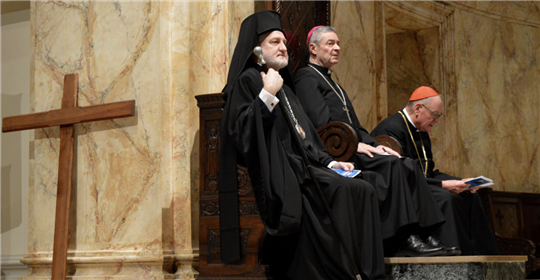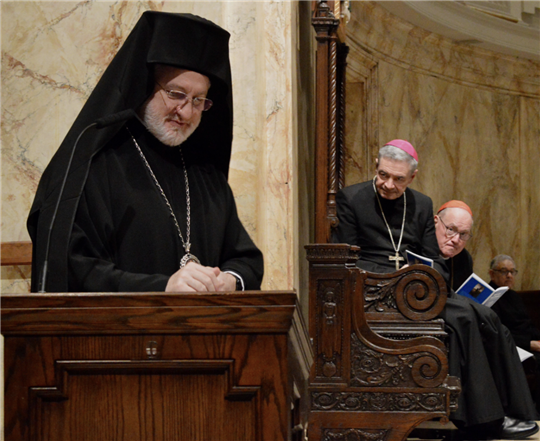
Crossing The Bridge: The Victory of Christ
A collaboration between CL in NYC and the Greek Orthodox Archdiocese of America led to walking the Way of the Cross together on Good FridayI received the news that Cardinal Dolan of New York had encouraged the planners of the Way of the Cross over the Brooklyn Bridge to invite the Greek Orthodox community of NYC to participate in this year’s procession as a direct response to a prayer of mine.
I grew up in both the Greek Orthodox and Roman Catholic Churches. Despite its liturgy playing a crucial role in my spiritual formation as a child, I struggled to find within Orthodoxy a concrete proposal for how to live a relationship with God in the modern world, as well as an intentional community with whom to live it. In college, I encountered several Catholics who took my desire for faith very seriously, inspiring me to ask to enter into full communion with the Catholic Church. 
While I was happy to have “come home,” two things left me unsettled. On one hand, this decision was not received well by my Orthodox family members. And on the other, Father Giussani’s educational method emphasized that the tradition with which we are raised is not to be thrown out the window, but to be critically engaged and assimilated into one’s path. I prayed that this shift in course would represent a new phase in my relationship with Orthodoxy, rather than a complete rupture from it, and that my particular path would in some way be united to something greater—namely, to the destiny of the whole Church and the world. Put simply, I wanted my journey to play some role in the future unity of the Churches.
Since my being fully received in the Catholic Church, my relationship with Greek Orthodoxy has deepened in surprising ways. I attribute much of this to my participation in the life of Communion and Liberation and following Giussani’s method, which have helped me to be attentive to all of the places in which Christ is revealing himself. And so, when the Greek Orthodox Archdiocese of America agreed to collaborate with the CL community of NYC to plan the 2025 Way of the Cross, I couldn’t help but feel that everything was coming full circle.
We were to begin our route at our usual starting point of St. James Cathedral Basilica in downtown Brooklyn, from which Cardinal Dolan of New York, Bishop Brennan of Brooklyn, and Archbishop Elpidophoros of the Greek Orthodox Archdiocese of America would lead us out on the Way of the Cross. Along the way, members of the CL and Greek Orthodox communities would take turns carrying the cross, until we arrived at our final destination: Saint Nicholas Greek Orthodox and National Shrine at World Trade Center, where the Greek Bishop Demetrios of Mokissos would welcome us along with Father Andreas, the vicar of the Shrine. The Shrine is a site that in a special way symbolizes the victory of Christ’s love over suffering and pain: It was built at the location where the original Saint Nicholas church burned down on September 11, 2001. 
Before Good Friday, two things struck me. First, my relationships with friends in CL and my brothers in the Memores Domini house continued to remind me that unity can only be reached through the grace of the Spirit, and not through our own efforts—no matter how noble they may be. Thus, I offered the desire for unity between the Churches in prayer during the Lenten season, doing penance for the sins that led to the fracturing of Christ’s body, and begging that the Spirit would dispose our hearts to being agents of communion and forgiveness rather than division and obstinacy.
Second, I was deeply moved during our planning calls with the representatives of the Shrine and the Greek Orthodox Department of Inter-Orthodox, Ecumenical, and Interfaith Relations. Unlike the many people I had encountered who were more interested in having polemical debates about the relationship between the two Churches—or those whose interest in ecumenism was at best for the sake of maintaining good public relations—I was inspired by the genuine attitude with which we all approached this ecumenical gesture. It was evident that this attitude of openness was rooted in our shared experience of Christ’s love—the more we are true to this love, we can’t help but cry out and beg that it redeem and unite all people within it.
After processing across the bridge from St. James, we finally arrived at St. Nicholas, while the chantor, Demetrios, sang the third stasis of the Egomia, the Byzantine lamentation hymns sung on Good Friday, which—since I was young—is perhaps the piece of liturgical music that has most spoken to me. After praying the last Station, reciting the Lord’s Prayer in English and Greek, and hearing closing remarks from the bishops, we processed into the church, where the CL choir sang the Salve Regina and Demetrios chanted the Axion Estin (a Byzantine Marian hymn).
In a very concrete and visceral way, these moments reminded me that Christ uses everything in our path to draw us closer to him. There’s a reason he allowed me to grow up caught between the fractures of his broken Body. And there’s a reason he placed the charism of Father Giussani in my path, because through it, I was given the tools to understand how each element of my path can be put to the service of fulfilling my desire to live in harmony with all the people in and aspects of my life, as well as of fulfilling Christ’s desire that “they may all be one.” The fact that he dared to answer my prayers in such a specific way was yet again a reminder of his great preference for me, inciting me to want to share this experience of such a great love with all of his Church and the rest of the world. I pray that I can continue sharing this missionary desire with my Orthodox brothers and sisters.
Stephen, Brooklyn, NY